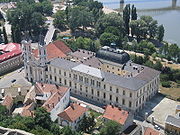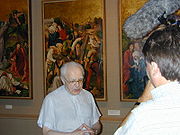
Christian Museum (Hungary)
Encyclopedia

Hungary
Hungary , officially the Republic of Hungary , is a landlocked country in Central Europe. It is situated in the Carpathian Basin and is bordered by Slovakia to the north, Ukraine and Romania to the east, Serbia and Croatia to the south, Slovenia to the southwest and Austria to the west. The...
; it conserves European and Hungarian works of art from the period between the 13th and 19th centuries.
The permanent exhibition of the Christian Museum is situated on the second floor of the Primate's Palace in Esztergom
Esztergom
Esztergom , is a city in northern Hungary, 46 km north-west of the capital Budapest. It lies in Komárom-Esztergom county, on the right bank of the river Danube, which forms the border with Slovakia there....
-Víziváros
Víziváros
Víziváros is a neighborhood of Esztergom, Hungary on the right bank of the Danube, under the royal castle and the St. Adalbert Primatial Basilica. The name Watertown derives from the numerous hot springs in the area.-History:...
, on the bank of the Danube
Danube
The Danube is a river in the Central Europe and the Europe's second longest river after the Volga. It is classified as an international waterway....
river.
The extensive collections of Hungarian, Italian
Culture of Italy
From antiquity until the 16th century, Italy was at the centre of Western culture, fulcrum or origin of the Etruscan civilization, Ancient Rome, the Roman Catholic Church, Humanism and the Renaissance....
, Dutch
Netherlands
The Netherlands is a constituent country of the Kingdom of the Netherlands, located mainly in North-West Europe and with several islands in the Caribbean. Mainland Netherlands borders the North Sea to the north and west, Belgium to the south, and Germany to the east, and shares maritime borders...
, German
Germany
Germany , officially the Federal Republic of Germany , is a federal parliamentary republic in Europe. The country consists of 16 states while the capital and largest city is Berlin. Germany covers an area of 357,021 km2 and has a largely temperate seasonal climate...
and Austria
Austria
Austria , officially the Republic of Austria , is a landlocked country of roughly 8.4 million people in Central Europe. It is bordered by the Czech Republic and Germany to the north, Slovakia and Hungary to the east, Slovenia and Italy to the south, and Switzerland and Liechtenstein to the...
n painting
Painting
Painting is the practice of applying paint, pigment, color or other medium to a surface . The application of the medium is commonly applied to the base with a brush but other objects can be used. In art, the term painting describes both the act and the result of the action. However, painting is...
s make this museum the third most important picture gallery in Hungary. Many works of art come from the territory of present-day Slovakia in which area part of the archdiocese of Esztergom lay at the time of the formation of the collection (the 1870s).
Besides late medieval and Renaissance works of art — including the Calvary Altarpiece by Thomas of Coloswar, the Lord's Coffin from Garamszentbenedek
Hronský Benadik
Hronský Beňadik is a village in central Slovakia...
, and the Passion scenes by Master MS
Master MS
Master M. S. was a 16th century painter who specialized in late Gothic art and in early Renaissance art.He was active in Banská Štiavnica and probably led a workshop there. Since his true name is unknown, he is sometimes identified with various other Gothic "masters"...
— the baroque and modern collections, the collection of the decorative arts, and the collection of prints and drawings are significant.
Collections on permanent display
- Hungarian, German and Austrian late GothicGothic artGothic art was a Medieval art movement that developed in France out of Romanesque art in the mid-12th century, led by the concurrent development of Gothic architecture. It spread to all of Western Europe, but took over art more completely north of the Alps, never quite effacing more classical...
paintingPaintingPainting is the practice of applying paint, pigment, color or other medium to a surface . The application of the medium is commonly applied to the base with a brush but other objects can be used. In art, the term painting describes both the act and the result of the action. However, painting is...
and sculptureSculptureSculpture is three-dimensional artwork created by shaping or combining hard materials—typically stone such as marble—or metal, glass, or wood. Softer materials can also be used, such as clay, textiles, plastics, polymers and softer metals...
(15–16th c.) - Italian RenaissanceRenaissanceThe Renaissance was a cultural movement that spanned roughly the 14th to the 17th century, beginning in Italy in the Late Middle Ages and later spreading to the rest of Europe. The term is also used more loosely to refer to the historical era, but since the changes of the Renaissance were not...
and BaroqueBaroqueThe Baroque is a period and the style that used exaggerated motion and clear, easily interpreted detail to produce drama, tension, exuberance, and grandeur in sculpture, painting, literature, dance, and music...
painting (13–18th c.) - Hungarian, Austrian, and German Baroque painting (17–18th c.)
- Early Netherlandish painting (15–16th c.)
- Tapestries (15–20th c.)
- IconIconAn icon is a religious work of art, most commonly a painting, from Eastern Christianity and in certain Eastern Catholic churches...
s and orthodox metalwork (16–20th c.) - Select works of the decorative arts – goldsmithworks, ivory carvingIvory carvingIvory carving is the carving of ivory, that is to say animal tooth or tusk, by using sharp cutting tools, either mechanically or manually. The ancient craft has now virtually ceased, as since CITES it is illegal under most circumstances throughout the world....
s, clockClockA clock is an instrument used to indicate, keep, and co-ordinate time. The word clock is derived ultimately from the Celtic words clagan and clocca meaning "bell". A silent instrument missing such a mechanism has traditionally been known as a timepiece...
s, caskets and snuff boxes, ceramic artCeramic artIn art history, ceramics and ceramic art mean art objects such as figures, tiles, and tableware made from clay and other raw materials by the process of pottery. Some ceramic products are regarded as fine art, while others are regarded as decorative, industrial or applied art objects, or as...
, glass paintings, eastern knotted carpetCarpetA carpet is a textile floor covering consisting of an upper layer of "pile" attached to a backing. The pile is generally either made from wool or a manmade fibre such as polypropylene,nylon or polyester and usually consists of twisted tufts which are often heat-treated to maintain their...
s (12–20th c.)
History

Kingdom of Hungary
The Kingdom of Hungary comprised present-day Hungary, Slovakia and Croatia , Transylvania , Carpatho Ruthenia , Vojvodina , Burgenland , and other smaller territories surrounding present-day Hungary's borders...
by opening his private collection to all visitors. The first exhibition installed on the upper floor of the Cathedral Library included 206 pictures, mainly late medieval and 19th-century works. The Archbishop greatly enlarged his collection in the following years. His most significant purchase was that of the Bertinelli collection in Rome
Rome
Rome is the capital of Italy and the country's largest and most populated city and comune, with over 2.7 million residents in . The city is located in the central-western portion of the Italian Peninsula, on the Tiber River within the Lazio region of Italy.Rome's history spans two and a half...
in 1878, when the Museum acquired sixty, mainly Italian Renaissance paintings. Further important acquisitions were the wooden sculptures and works of applied art bought in 1884 from the Schnütgen Collection
Schnütgen Museum
The Schnütgen Museum in Cologne , Germany is devoted to Christian religious art, mainly medieval, but some parts of the collection, such as its textiles and prints, extend from antiquity to the modern period...
in Cologne
Cologne
Cologne is Germany's fourth-largest city , and is the largest city both in the Germany Federal State of North Rhine-Westphalia and within the Rhine-Ruhr Metropolitan Area, one of the major European metropolitan areas with more than ten million inhabitants.Cologne is located on both sides of the...
. After 1882, the enlarged collection was transferred to the second floor of the newly rebuilt Primate’s Palace on the Danube
Danube
The Danube is a river in the Central Europe and the Europe's second longest river after the Volga. It is classified as an international waterway....
bank, where it is still located. In 1887, Simor ensured the future of the collection by entrusting it to the care of the Cathedral chapter of Esztergom
Esztergom
Esztergom , is a city in northern Hungary, 46 km north-west of the capital Budapest. It lies in Komárom-Esztergom county, on the right bank of the river Danube, which forms the border with Slovakia there....
. After World War I, the Museum was enriched with two large collections: in 1920 with the collection of Arnold Ipolyi, Bishop of Oradea (1823–1886), which consisted mainly of late medieval Italian, German, Austrian and Hungarian paintings and sculptures, and in 1925 with Count San Marco's bequest, which primarily contained works of applied arts and paintings.

